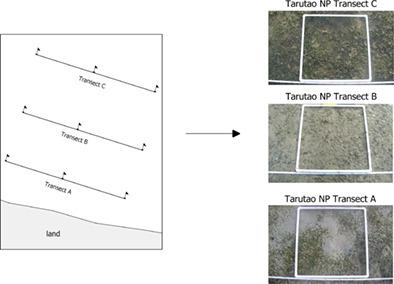当前位置:
X-MOL 学术
›
Ecol. Res.
›
论文详情
Our official English website, www.x-mol.net, welcomes your
feedback! (Note: you will need to create a separate account there.)
Monitoring of seagrass along southern Andaman coast of Thailand
Ecological Research ( IF 1.7 ) Pub Date : 2020-08-21 , DOI: 10.1111/1440-1703.12123 Ekkalak Rattanachot 1 , Milica Stankovic 1 , Piyalap Tuntiprapas 1 , Supaporn Prempree 2 , Anchana Prathep 1, 3
Ecological Research ( IF 1.7 ) Pub Date : 2020-08-21 , DOI: 10.1111/1440-1703.12123 Ekkalak Rattanachot 1 , Milica Stankovic 1 , Piyalap Tuntiprapas 1 , Supaporn Prempree 2 , Anchana Prathep 1, 3
Affiliation

|
Seagrass ecosystems provide various important ecosystem services in the marine environment. However, their global distribution has been declining since the 1800s. At the current rate of decline of almost 1.5% per year, almost half the meadows will be lost in the next 100 years. To prevent or minimize their loss, global monitoring programs have been established, such as SeagrassNet. The aim of the program is to introduce a global monitoring protocol and to preserve seagrass ecosystems by increasing scientific knowledge of them. The aim of this study was to gather data obtained by this protocol and to set a baseline for knowledge of the seagrass meadows in marine national parks in Southern Thailand. The data were collected from February 2006 until March 2009, three times a month at three national parks: Haad Chao Mai, Tarutao and Mu Ko Petra. At each site, the data were obtained along three transects parallel to the coast with 12 quadrats, in which species coverage and biomass above and below ground were recorded. These data sets can be used in future seagrass health assessments, in observation of the temporal changes of the meadows and as a baseline for restoration efforts.
中文翻译:

监测泰国南部安达曼海岸的海草
海草生态系统在海洋环境中提供了各种重要的生态系统服务。但是,自1800年代以来,它们的全球分布一直在下降。以目前每年近1.5%的下降速度,在接下来的100年中,几乎一半的草地将消失。为了防止或最大程度地减少其损失,已经建立了全球监控程序,例如SeagrassNet。该计划的目的是引入一项全球监测协议,并通过增加对海草生态系统的科学知识来保护它们。这项研究的目的是收集通过该协议获得的数据,并为了解泰国南部海洋国家公园中的海草草甸奠定基础。数据收集自2006年2月至2009年3月,每月在三个国家公园(哈德迈迈,塔鲁陶和Mu Ko Petra)收集3次。在每个站点上,沿着与海岸平行的三个样带(具有12个四边形)获取数据,记录了地面上和地下的物种覆盖率和生物量。这些数据集可用于未来的海草健康评估,观察草甸的时间变化并作为恢复工作的基准。
更新日期:2020-09-23
中文翻译:

监测泰国南部安达曼海岸的海草
海草生态系统在海洋环境中提供了各种重要的生态系统服务。但是,自1800年代以来,它们的全球分布一直在下降。以目前每年近1.5%的下降速度,在接下来的100年中,几乎一半的草地将消失。为了防止或最大程度地减少其损失,已经建立了全球监控程序,例如SeagrassNet。该计划的目的是引入一项全球监测协议,并通过增加对海草生态系统的科学知识来保护它们。这项研究的目的是收集通过该协议获得的数据,并为了解泰国南部海洋国家公园中的海草草甸奠定基础。数据收集自2006年2月至2009年3月,每月在三个国家公园(哈德迈迈,塔鲁陶和Mu Ko Petra)收集3次。在每个站点上,沿着与海岸平行的三个样带(具有12个四边形)获取数据,记录了地面上和地下的物种覆盖率和生物量。这些数据集可用于未来的海草健康评估,观察草甸的时间变化并作为恢复工作的基准。











































 京公网安备 11010802027423号
京公网安备 11010802027423号